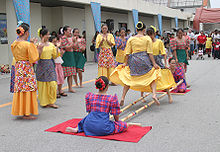
Tinikling
Encyclopedia

Dance
Dance is an art form that generally refers to movement of the body, usually rhythmic and to music, used as a form of expression, social interaction or presented in a spiritual or performance setting....
from the Philippines
Philippines
The Philippines , officially known as the Republic of the Philippines , is a country in Southeast Asia in the western Pacific Ocean. To its north across the Luzon Strait lies Taiwan. West across the South China Sea sits Vietnam...
that involves two people beating, tapping, and sliding bamboo
Bamboo
Bamboo is a group of perennial evergreens in the true grass family Poaceae, subfamily Bambusoideae, tribe Bambuseae. Giant bamboos are the largest members of the grass family....
poles on the ground and against each other in coordination with one or more dancers who step over and in between the poles in a dance. The name is a reference to birds locally known as tikling, which can be any of a number of rail
Rallidae
The rails, or Rallidae, are a large cosmopolitan family of small to medium-sized birds. The family exhibits considerable diversity and the family also includes the crakes, coots, and gallinules...
species; the term tinikling literally means "tikling-like."
Tinikling involves five steps; during the first four steps, the dancers dance opposite each other, and during the last step, they start from the same side of the poles.
The bamboo is also used as a percussive instrument as it is banged against the ground (or a piece of wood to make it easier to hold) and each other in a pattern. The bamboo has to be closed hard enough to make a sound, and the dancers must be quick enough to not get their foot (or feet) caught. As the dance continues, the banging of the bamboo becomes faster and harder, the sound of the clashing bamboo and the quickness of feet demonstrated by the dancers thrilling and awing the crowd. In the United States, this dance had been altered into a four-beat rhythm to adjust to popular music. In some cases, it has been used in conjunction with traditional Filipino martial arts to demonstrate fleetness of foot and flow of movement.
The dance originated in Leyte
Leyte
Leyte is a province of the Philippines located in the Eastern Visayas region. Its capital is Tacloban City and occupies the northern three-quarters of the Leyte Island. Leyte is located west of Samar Island, north of Southern Leyte and south of Biliran...
among the Visayan
Visayas
The Visayas or Visayan Islands and locally known as Kabisay-an gid, is one of the three principal geographical divisions of the Philippines, along with Mindanao and Luzon. It consists of several islands, primarily surrounding the Visayan Sea, although the Visayas are considered the northeast...
islands in the central Philippines as an imitation of the tikling bird dodging bamboo traps set by rice farmers. The dance imitates the movement of the tikling birds as they walk between grass stems, run over tree branches, or dodge bamboo traps set by rice farmers. Dancers imitate the tikling bird's legendary grace and speed by skillfully maneuvering between large bamboo poles.
Sources
http://www.likha.org/galleries/tinikling.asphttp://www.giancruz.com/portfolio/imd110/city/history.html#top

